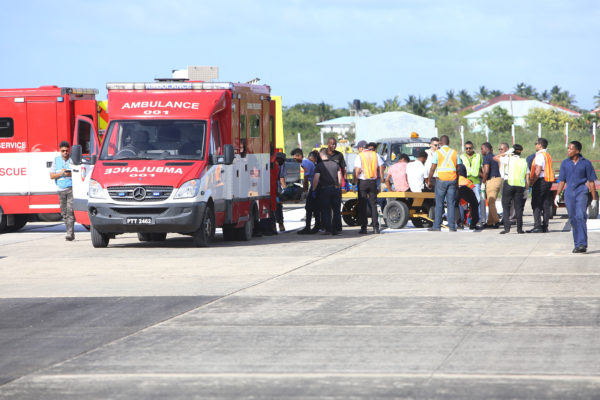The Ogle Airport Inc. (OAI) carried out a full-scale Mass Casualty Inci-dent Management (MCIM) simulation yesterday afternoon at the Eugene F. Correia International Airport (EFCIA) and was given seven out of 10 by an aviation safety official.
Spokesperson for OAI, Kit Nascimento explained that the situation that was being acted out, was an incident where a passenger on a LIAT airplane, which was landing at the airport, had started shooting, causing the airplane to crash, and resulting in more than a dozen of the 60 passengers being injured.
The simulation commenced at the eastern end of the runway, where two buses were positioned to represent the crashed aircraft.

According to the information gathered from various officers who were in charge of coordinating the exercise, at around 3:10 pm, a report was made to the control tower of several gunshots going off in the cockpit of the airplane.
Some five minutes later, Stabroek News recorded two police vehicles racing onto the runway, in the direction of where the crash had occurred. At the other end of the airport, at the GuySuCo Hangar, which had been converted to an emergency medical station, staff from the airport who had assembled with stretchers, dashed off to the scene on foot and in baggage tractors, to render assistance. Shortly after, several ambulances and a fleet of police vehicles raced onto the tarmac, heading for the crash site.
Dozens of policemen of all ranks stormed out of their vehicles, with some cordoning off the area by forming a perimeter around the scene, as other ranks got closer to the crash site to contain the situation.
Meanwhile, the staff of nurses and paramedics continued to go back and forth to the damaged airplane, from where they were collecting the injured, and transporting them to the triage zone (emergency medical station) where they were receiving treatment. Those with serious injuries were transported to hospitals while the rest of the passengers were treated on site. For the badly injured who required immediate medical attention, a helicopter was seconded to assist with evacuation.
At the end of the exercise, the officers in charge explained that according to the information they were able to gather, the perpetrator shot and killed five of the passengers, before turning the gun on himself. His body along with the other dead passengers were removed last, according to protocol.
At the conclusion of the seventy-five minute exercise, Rex Hamza, the Director of Aviation Safety Regulations from the Civil Aviation Authority, said he was pleased with the exercise, which was an improvement on the last one from two years ago, and gave it a seven out of 10 rating.
“Much of what is being done, we are observing to see whether those procedures that are outlined in the emergency evacuation plan are being carried out the way it was written,” Hamza said, while stating that the observations and findings will be communicated back to the OAI so that they can be improved upon.
“Any exercise of this nature can only get better with repetition. The more we repeat it, the better we will be able to hone it into what it should be eventually, and so those are some of the things we look at when we are looking at a simulation,” he added.
He explained that so far, from his observation of the simulation, communication is one of the key areas that needs to be worked on, which he said can be improved in time. He added that because of the technological advancements that are being made daily, communication should be improved greatly.
“A drone may be able to give you a better understanding of what is happening at the site, and you can make decisions within the emergency room,” he suggested.
Comparing the two simulations, Hamza said that there was better coordination this time, between what was happening at the site and in the triage zone.
In terms of having the simulation more often, Hamza related that they are currently adhering to the international standard of having it every two years but increasing its frequency would be considered. “The physical exercise should start once a year. We already have the table top that’s carried out within a room, and this is just the physical thing, and of course you can see the logistics involved in doing a simulation, and maybe it’s something we need to sit down and look at on the drawing board,” he noted.
In addition to increasing the frequency of the simulations, Hamza added that training needs to be increased. “Remember OAI has so many people working here and having them trained at the same level will happen over the years. Sometimes you train people and they move on and you lose those persons and you need to look at how many you’ve trained, and at what level of training you’ve done, so they can be the key players,” he said, adding that they will sit with the airport’s administration, where they will discuss and weigh the cost and effect of the exercise.
Lieutenant Jack McGovern of the Fredericksburg, Virginia Fire Service, in the USA, who served as the facilitator for the exercise, lauded the simulation and gave it a 7.5 out of 10 rating.
Collaboration was had with the Georgetown Public Hospital, Davis Memorial Hospital, St. Joseph Mercy Hospital, Woodlands Hospital, the Guyana Police Force and the Guyana Fire Service.